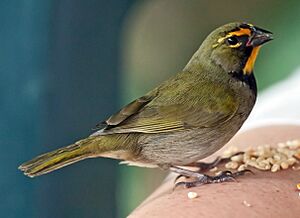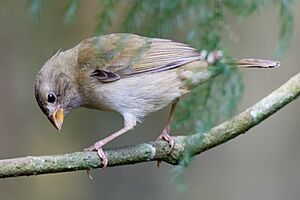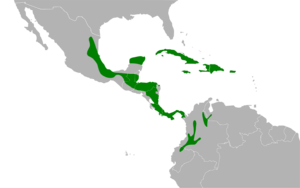Yellow-faced grassquit facts for kids
Quick facts for kids Yellow-faced grassquit |
|
|---|---|
 |
|
| Male in Jamaica | |
 |
|
| Female in Jamaica | |
| Conservation status | |
| Scientific classification | |
| Genus: |
Tiaris
|
| Species: |
olivaceus
|
 |
|
| Synonyms | |
|
|
The yellow-faced grassquit (Tiaris olivaceus) is a small passerine bird. It belongs to the tanager family, called Thraupidae. This bird is the only species in its group, known as the genus Tiaris. You can find it living naturally in Central America, South America, and the Caribbean islands.
Contents
About the Yellow-faced Grassquit
How Scientists Name Birds
Scientists use a system called binomial nomenclature to give every living thing a unique two-part name. This helps everyone know exactly which species they are talking about.
The yellow-faced grassquit got its scientific name, Emberiza olivacea, from a famous Swedish naturalist named Carl Linnaeus in 1766. The word olivaceus means "olive-green" in Neo-Latin, which describes the bird's color. Later, in 1827, an English naturalist named William Swainson created the genus Tiaris for this bird.
For a long time, the yellow-faced grassquit was thought to be related to buntings and New World sparrows. But in 2014, scientists studied the bird's DNA. They found out it actually belongs to the tanager family, Thraupidae. It's now part of a group that includes Darwin's finches.
Different Types of Yellow-faced Grassquits
There are five slightly different types, or subspecies, of the yellow-faced grassquit:
- T. o. pusillus: Found from eastern Mexico all the way to Ecuador and Venezuela.
- T. o. intermedius: Lives on the island of Cozumel near southeast Mexico.
- T. o. ravidus: Found on Coiba Island off the coast of south Panama.
- T. o. olivaceus: This is the original type. It lives in Cuba, the Cayman Islands, Jamaica, and Hispaniola (which includes the Dominican Republic and Haiti).
- T. o. bryanti: Lives in Puerto Rico and nearby islands.
What Does It Look Like?
The yellow-faced grassquit is a small bird. It has a cone-shaped beak, which is sharper than those of similar birds called seedeaters. It is about 10–10.7 cm (3.9–4.2 in) long. It weighs around 8–10 g (0.28–0.35 oz), which is about the same as a few paper clips.
Male Birds
Adult male yellow-faced grassquits have an olive-green back. Their face and chest are black. But they have bright yellow patches on their throat, above their eyes (called supercilia), and a yellow spot below their eyes. The rest of their belly is a grayish-olive color. Their beak and eyes are dark, and their legs are grey.
Female Birds
Female yellow-faced grassquits are usually a bit smaller than males. They are a duller olive-green on top and lighter grey underneath. They might have some dark smudges on their chest. Their yellow face pattern is much lighter and harder to see. The lower part of their beak is a light grey color.
Young Birds
Young yellow-faced grassquits look a lot like the adult females. However, they are even duller and greyer. Young males start to get their bright adult colors during their first year.
What Does It Sound Like?
The yellow-faced grassquit makes a soft, buzzing, trilled sound that goes ttttt-tee. Its song is a changing series of high, thin, fast trills. When it sings for a long time, it sounds sweet but quiet. You often have to be close by to hear it.
Where Does It Live?
This bird lives and breeds from central Mexico down to northern Ecuador and northwestern Venezuela. It also lives on the Greater Antilles and nearby islands in the Caribbean.
The yellow-faced grassquit does not migrate long distances. However, it does move around outside of its breeding season. Sometimes, these birds have been seen in southern Texas and Florida. People have also introduced them to Hawaii.
You can often find the yellow-faced grassquit in lowlands and foothills, up to 2,300 m (7,500 ft) high. They like places that are partly open, like roadsides, pastures, weedy fields, and low bushes. They don't like very dry grasslands. But they love overgrown gardens where the grass has grown tall.
These birds are quite friendly and sometimes form small groups with other tanagers or similar birds. Sometimes, adult males will even gather in a bush to sing together.
What Does It Eat?
The yellow-faced grassquit mainly eats grass seeds. But it also enjoys other types of seeds, small berries, and some insects. They usually pick seeds directly from the plant's flower heads. They also find food on the ground. When hunting insects, they search among leaves, similar to how New World warblers do.
Reproduction and Life Cycle
The main time for yellow-faced grassquits to breed is during the summer months. However, they can also build nests at other times of the year, except from February to April. Sometimes, these birds form small groups of nests close to each other.
During courtship, the male bird vibrates his wings while singing his quiet song. He sits very close to the female, only 1–2 in (2.5–5.1 cm) away, so she can hear him clearly.
The female builds a round-shaped nest. She uses grass and plant stems, packing them together to make a thick nest. She lines the inside with soft pieces of grass flowers and plant fibers. The nest has an opening on the side. It is usually placed less than 30 cm (12 in) above the ground. You can often find it among grass or weeds on a road or river embankment. Sometimes, they build nests in bushes up to 1.5 m (4.9 ft) high.
The female lays two or three eggs, but sometimes four. The eggs are white with brown speckles. The female sits on the eggs to keep them warm (this is called incubation) for 12 to 14 days until they hatch.
Conservation Status
The yellow-faced grassquit is not a rare bird. It is found in many places. Because of this, the IUCN (International Union for Conservation of Nature) lists it as a species of "Least Concern". This means it is not currently at risk of disappearing. In fact, it seems to do well when forests are cut down. Its numbers are growing, and it is spreading to new areas. For example, it has only been known in the eastern Andean mountains of Meta Department in Colombia since 1997.



